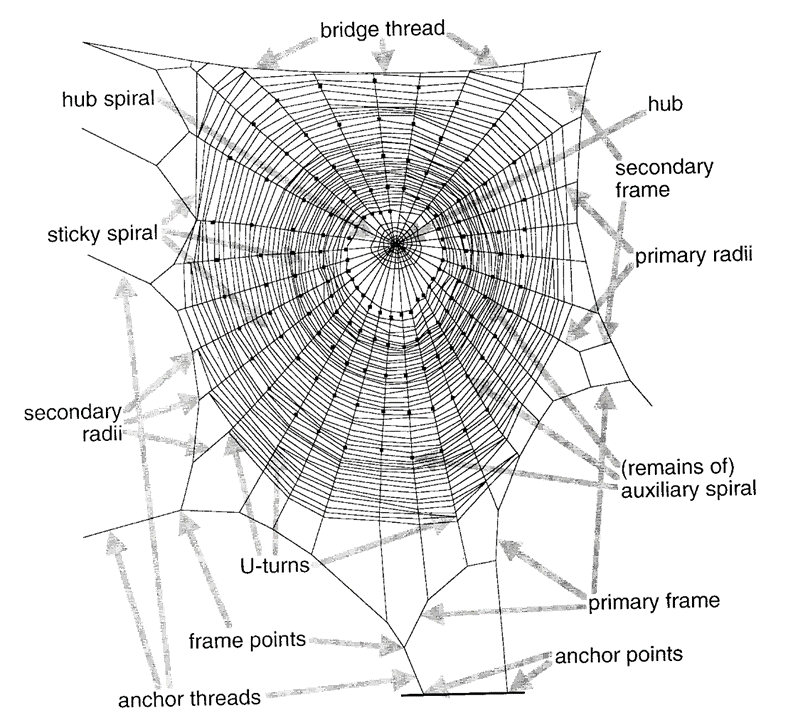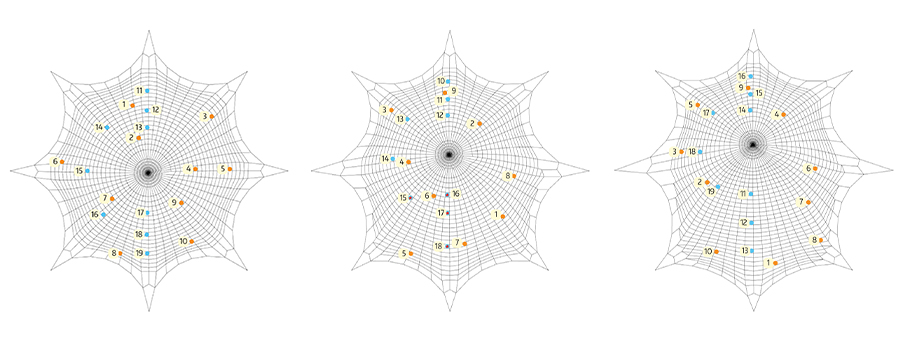Engineering ‘spidey-senses’
Spiders can inform how we engineer sensing structures without sensors.
By: Amy Sprague
Spiderwebs are an engineering marvel with practical aerospace and robotics applications. A&A doctoral student Thijs Masmeijer, a researcher in A&A’s Illimited Lab, just returned from the University of Ljubljana’s Ladisk Lab in Slovenia with a Boeing Fellowship to advance the research of the structural properties of these silky creations.
He says, “Spiderwebs are not just a spider’s home. They are multifunctional structures. Not only do they capture prey, but they also relay to the spider what just got caught, how big it is and where exactly it is located in the web.” In engineering terms, we call this information transmission through vibrations signaling in a network. It’s this rapid signaling in the web that gives the spider the reputation of precognition known as “spidey-senses.”
For Masmeijer, who has turned his attention from snakes to spiders, engineering these spidey-senses into structures could yield structural benefits for aerospace and robotics with applications for damage and impact sensing, noise reduction, energy steering and more, especially for flexible structures.
The speed of spiders reacting to a stimulus in their webs contributes to the concept of “spidey-senses.” Video by the Oxford Silk Group on YouTube.
Functionalized geometries

The geometry of spiderwebs results from careful construction and strategic placement. They are intentionally not symmetrical. Spiders also use different types of silk to create various elements of their webs, each serving a specific purpose. The radial threads, also known as spokes, radiate outwards from the off-center hub of the web, forming a framework for support. These threads are typically stronger and stiffer than others.
Connected to these radial threads are spiral threads that form concentric circle-like shapes around the web. These spirals consist of sticky silk that captures unsuspecting prey. The spacing between these spiral threads varies depending on the spider species and its hunting strategy. Bridge lines strengthen the overall structure and provide stability against wind or disturbances.
Masmeijer has been working off of a hypothesis that recurring and distinct architectural choices found in spider webs provide “extended cognition” for sensing, localizing prey or damage, and applying structural maintenance when needed. Understanding these geometric features and how they contribute to sensing can advance creating innovative flexible structures with enhanced functionality.



Left: Potential application is webbing on a flexible wing aircraft. Plane rendering courtesy of NASA, with webbing overlaid by M. J. Koo. Top right: In the lab setup, the 3D-printed web is suspended in an octagonal frame. An impact hammer disturbs the web and records the transfer of forces during impact, which is filmed. Bottom right: Close-up of the 3D-printed web.
3D spiderwebs and high-speed imaging
Testing the “precognition” of a spiderweb requires a creative approach. For this, Masmeijer turned to the University of Ljubljana’s Ladisk Lab under Professor Janko Slavič. The lab, specializing in nonlinear mechanical vibrations, signal processing and digital image correlation developed imaging methodologies to detect very tiny movements.
The researchers created a frame within which they threaded a 3D-printed spiderweb. The Ladisk Lab specializes in the Lucas-Kanade method of optical flow estimation and a simplified Optical Flow method. The testing is set up that these methods will work well to capture the effects of small disturbances on the web. This method can detect displacement across a distance less than a pixel through measuring the change in light entering the camera lens across that pixel.

“Our goal is to emulate the spider's clever geometric designs in engineering structures that allow us, just like a spider, to eliminate the need for complex algorithms or computational requirements for sensor networks.”
Where is this research heading?
Engineers already use various sophisticated algorithms such as neural networks, system identification, and other methods to optimize the location of sensors to aid in damage sensing. But as professor Ed Habtour, Masmeijer’s faculty adviser explains, the spider’s approach to damage identification is much simpler and more elegant than these complex algorithms. He says, “The web’s geometric patterns enable the structure to function as a sensor network without sensors. Just like a guitar string, each geometric feature on the web has its own unique vibration signal like a tone.”
“We think some degree of asymmetry would make these algorithms perform better. Spiderwebs are a great proof of concept.”

Habtour continues, “The hypothesis is that the web’s asymmetric connectivity of its geometric features is key for translating the vibration signal, or data, into useful information. Our goal is to emulate the spider's clever geometric designs in engineering structures that allow us, just like a spider, to eliminate the need for complex algorithms or computational requirements for sensor networks. We want to know how these creatures build a sensor network without sensors.”
For now, Masmeijer has a big task analyzing the data he collected in Slovenia. He says, “We will see what the data says regarding small asymmetric connectivity versus symmetric connectivity. We think some degree of asymmetry would make these algorithms perform better. Spiderwebs are a great proof of concept.”

A demonstration of the Simplified Optical Flow method on a section of a vibrating string. Usually this method is applied with vibration amplitudes of the sub-pixel level. As shown, the researchers are close to applying it to large amplitude vibrations.
Using a hammer to represent prey making a small impact. The mass in the center of the web is where a spider would usually be residing and monitoring the web.